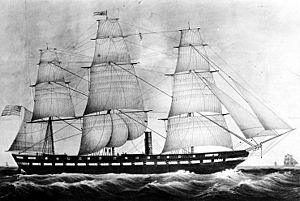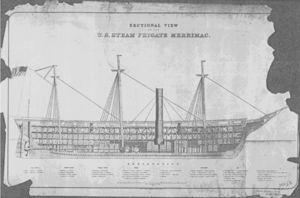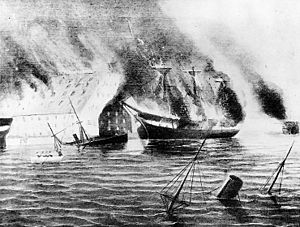USS Merrimack (1855) facts for kids

USS Merrimack; Engraving by L.H. Bradford & Co., after a drawing by G.G. Pook
|
|
Quick facts for kids History |
|
|---|---|
| Name | Merrimack |
| Ordered | 6 April 1854 |
| Launched | 15 June 1855 |
| Commissioned | 20 February 1856 |
| Decommissioned | 16 February 1860 |
| Fate |
|
| General characteristics | |
| Tonnage | 3,200 |
| Length | 275 ft (84 m) |
| Beam | 38.5 ft (11.7 m) |
| Draft | 24 ft (7.3 m) |
| Propulsion | sail, steam engine |
| Speed | 12 knots |
| Armament |
|
The USS Merrimack was a powerful steam frigate. It was a type of warship that used both sails and a steam engine. This ship is most famous for its role in the American Civil War.
After the Merrimack was burned and sunk, its main body (called the hull) was used to build a new ship. This new ship was an ironclad warship named CSS Virginia. The CSS Virginia later fought in the famous Battle of Hampton Roads. This battle was the first time two ironclad warships fought each other.
The Merrimack was the first of six "screw frigates" built starting in 1854. Screw frigates used a propeller (a "screw") to move through the water. Like its sister ships, the Merrimack was named after a river. The Merrimack River flows through New Hampshire and Massachusetts.
Contents
The Merrimack's Story
Building the Ship
The Merrimack was built at the Boston Navy Yard. It was launched on June 15, 1855. A "ship sponsor" is someone who officially names and launches a ship. For the Merrimack, this was Mary E. Simmons.
The ship officially joined the Navy on February 20, 1856. Captain Garrett J. Pendergrast was its first commander. This was the second ship in the U.S. Navy to be named after the Merrimack River.
Early Journeys
The new screw frigate went on "shakedown cruises." These are test trips to make sure everything on the ship works correctly. The Merrimack sailed to the Caribbean Sea and parts of Western Europe.
It visited cities like Southampton in England, Brest in France, Lisbon in Portugal, and Toulon in France. After these trips, it returned to Boston. The ship was then taken out of service on April 22, 1857, for repairs.
Pacific Ocean Service
The Merrimack was put back into service on September 1, 1857. It left Boston Harbor on October 17. It became the main ship, or "flagship," for the Pacific Squadron.
The ship sailed around Cape Horn, which is the southern tip of South America. It then cruised along the Pacific coast of South and Central America. The Merrimack headed back home on November 14, 1859. When it returned to Norfolk Navy Yard, it was taken out of service again on February 16, 1860.
The Civil War and a New Life
The Merrimack was not in active service when the American Civil War was about to begin. As tensions grew, the U.S. Navy planned to move the ship to Philadelphia. However, on April 17, 1861, the state of Virginia decided to leave the United States.
People who supported the Confederacy sank small boats in the channel. This blocked the Merrimack from leaving the Norfolk Navy Yard. To prevent the ship from being captured by the Confederacy, the U.S. Navy set it on fire and sank it on April 20, 1861.
The Confederacy badly needed warships. They raised the Merrimack's sunken hull. They then rebuilt it into a powerful ironclad ship. This new ship was designed by Lt. John Mercer Brooke.
On February 17, 1862, the rebuilt ship was officially named CSS Virginia. The Confederacy hoped this ironclad would destroy the Union's wooden ships. They also hoped it would end the Union's naval blockade, which was hurting their war efforts.
External links
See also
 In Spanish: USS Merrimack (1855) para niños
In Spanish: USS Merrimack (1855) para niños



